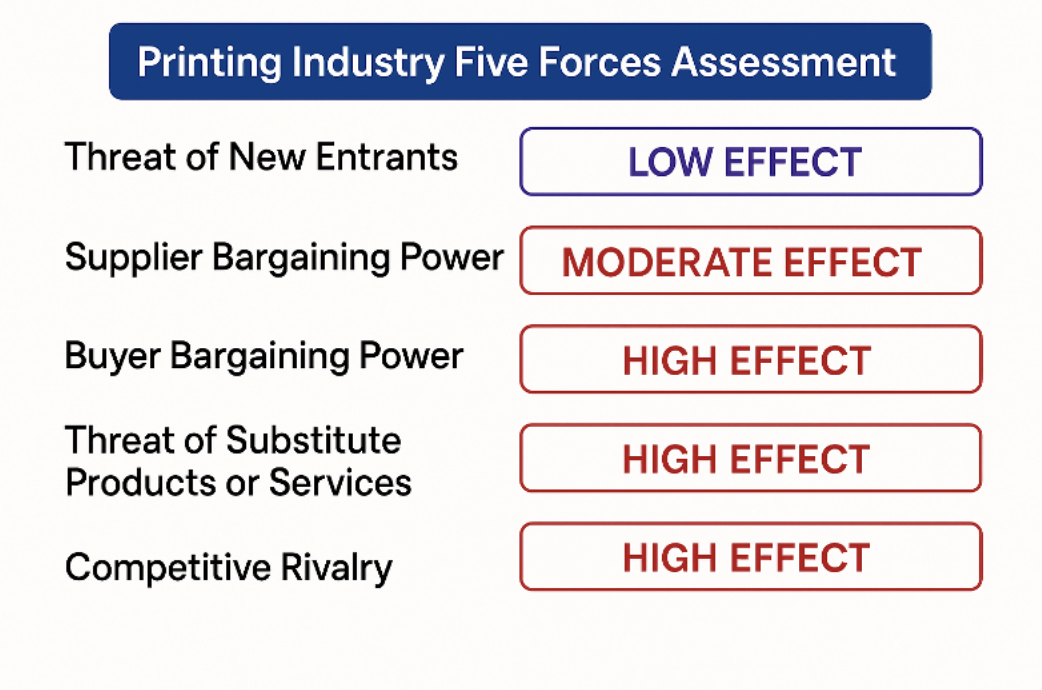Our Industry is Challenged, But Our Findings Show High Performers!
We open by assessing our industry using Michael Porter’s Five-Forces model. Then, we share some findings from our February/March 2025 “Printing Industry Performance & Insights” study. Compared to our industry assessment, our study’s findings are a bit surprising. One might see our findings as “striking.” We close with some actionable takeaways.
Michael Porter’s Five-Forces model provides a good framework for assessing the profit potential of an industry’s companies. Porter’s model points to assessing these five areas: Threat of New Entrants, Supplier Bargaining Power, Buyer Bargaining Power, Threat of Substitute Products or Services, and Competitive Rivalry. For each force, we rate it as low, moderate, or high. A low effect is good, and a high effect is concerning.
We asked AI to assess our industry from a Five-Forces view. Did we agree with every Five-Forces point AI provided about our industry… “No.” But AI’s points generally supported our view.
Threat of New Entrants
The high capital equipment, technology, and facilities investments needed to start a new printing company may form “Barriers to Entry” for firms seeking to enter our industry. Also, current printing companies’ long-standing relationships with current customers may deter newcomers. A new printing company may face challenges in reaching the level of scale needed to price their printed products competitively with existing firms. Therefore, we see the threat of new entrants as having a Low Effect on our industry.
Supplier Bargaining Power
When I led a printing company, a decade or so ago, paper was a commodity that was easy to shop for and purchase. But, as shown in the post-pandemic paper shortages, the paper supply chain has changed. The present paper purchasing environment is not as challenging as it was a couple of years ago. But we continue to see paper mills closing or converting to corrugated material.
Adding to the paper supply chain challenges, a relatively small number of suppliers dominate printing equipment. Furthermore, the current international trade and tariff environment may adversely affect the paper supply chain and printing equipment, as it has affected printing plates. As the paper supply chain has improved over recent years, and tariffs have not had a substantial impact, we see supplier bargaining power as having a Moderate Effect on our industry.
Buyer Bargaining Power
Customers’ ability or willingness to change to another printing company varies significantly.
Through services like fulfillment, some printing firms build strategic bonds with customers. However, from a general view, we see most printing customers as having “low switching costs” – It’s relatively easy to change printing companies.
Many print buyers focus on price, treating print as a commodity. Also, quality has become more of a “standard” and an expectation. Substitute products or services (discussed next) may reduce the number of print customers, increasing print customer buyer power. Therefore, we see customer bargaining power as having a High Effect on our industry.

Threat of Substitute Products or Services
Emails, websites, social media, and e-documents (e-books) are common substitutes for printed products. Also, QR codes and AR experiences may replace some traditional printed materials.
Although the effectiveness of tangible printed communication is often seen in results, the low costs of digital media and sociocultural trends may pull print customers away.
In addition, environmental and sustainability trends may draw print customers to go paperless. Therefore, we see the threat of substitute products or services as having a High Effect on our industry.
Competitive Rivalry
The growing printing efficiency, in the context of substitute products discussed just above, may prompt more competition among printing companies.
In recent years, we’ve seen multiple mergers of printing companies. As companies merge, their increased economies of scale (lower costs to produce more) may prompt more pricing competition. Here’s an example of competitive rivalry we’ve seen in our industry. A couple of years ago, we had to cease quarterly luncheons including printing company leaders in a city. The competitive rivalry was so intense that we were afraid to have various printing company leaders in one room. Therefore, we see the threat of competitive rivalry as having a High Effect on our industry.
The graphic below summarizes our assessments, which are completely subjective. Your assessments may differ from ours, and we respect that. Also, we considered these assessments from a “general commercial printing” view. A view from another industry segment, such as labels or folded cartons, may produce different assessments. Printing company leaders, you might step back and consider each of the five forces’ effect on your industry segment.
We propose that our industry has one “moderate effect” force and three “high effect” forces. Normally, an industry with three “high effect” forces is considered challenged, generally an industry without solid profit potential.
In the context of our five-forces analysis, our February/March 2025 “Printing Industry Performance & Insights” findings are interesting. Our 108 participating printing firms experienced an average of 4.2% revenue growth from 2023 to 2024. Twenty-eight of those firms had a growth of 10% or higher, with eight firms with 25% growth. Seventy-nine firms reported their EBITDA percentage, with an average of 12.2%. Seventeen of those firms had EBITDA exceeding 20%. Our 2025 findings are not an anomaly. Every time we’ve explored revenue growth and EBITDA over the past years, we’ve found a significant number of high-performing firms.
Yes, our industry has challenges. But there are high-performing firms in our industry!
Actionable Takeaways
If your firm is not growing and solidly profitable, see that potential. (BTW – our report shows a positive relationship between growth and profitability… Dah! 😉) There are high-performing firms in our industry – see the potential!
Consider these steps:
- Create a vision of high performance among your team – “We can do this!”
- Develop a strategic mission: What is the niche market we are targeting? What unique and beneficial products/services do we provide our targeted customers? What value do we provide our targeted customers? What will make our customers not consider switching to a competitor?
- As Warren Buffett says, “Build a competitive moat around your company!”
- Develop a strategic plan for identifying potential new customers in your target market, contacting them, and marketing to them.
- Market the value of your products/services, maybe with examples of how your products/services helped customers.
- Budget – have a financial plan for strong profitability.
- All the steps are part of a continuous process. Continue to monitor and adjust as needed.
Closing Thoughts
Our report, titled “The Printing Industry: A Broad Overview From our ‘Printing Industry Performance & Insights’ Survey,” is available from regional printing associations. The report covers the following topics:
- Revenue Change from 2023 to 2024
- EBITDA Averages
- Revenue and Profitability Outlook
- Staffing and Equipment Plans
- Increasing Costs for Various Items
- Printing Plates Availability and Cost
- Recession Expectations
Help us develop helpful, actionable knowledge for you by participating in our future surveys, which we plan to make much shorter in the future. Contact Ralph Williams with questions or suggestions.
Author: Dr. Ralph Williams, Associate Professor of Management, Jones College of Business, Middle Tennessee State University


